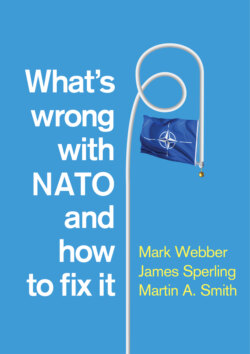Читать книгу What's Wrong with NATO and How to Fix it - Mark Webber - Страница 13
There is no substitute for NATO
ОглавлениеThe particular institutional form the Alliance has taken marks it out from other organizational alternatives. The EU, the United Nations (UN) and the Organization for Security and Cooperation in Europe (OSCE) can all lay claim to promoting security. None, however, is possessed of the institutional and military assets described above. None would have been capable of mounting combat operations in the Balkans, Libya and Afghanistan, or of replicating NATO’s Readiness Action Plan to provide reassurance to the Baltic States and Poland in the face of Russian military might.
Three other points are also worth making by way of comparison. First, the US and the UK have consistently given priority to NATO. That choice determined NATO’s European ascendancy at the end of the Cold War. London and Washington have ever since been lukewarm about the idea of an EU role in military security for fear that it will encroach upon alliance prerogatives. As the UK exits from the EU, such scepticism is only likely to increase. Non-EU Turkey has adopted a similar stance. France and Germany, by contrast, have tended to talk up the security and nascent military functions of the EU, but neither has ever contemplated abandoning NATO in order to support a distinct European alternative.
Related to this, NATO enjoys a privileged position in the ‘organizational ecology’ of international security provision.24 Once the Alliance’s primacy had been asserted at the end of the Cold War, possible alternatives became complementary to its efforts not substitutes for them. Thus, in Bosnia, NATO worked alongside the UN to enforce a series of Security Council Resolutions. NATO’s peacekeeping force in the country eventually gave way to an EU operation (EUFOR Althea), a mission reliant on close cooperation between the EU Military Staff and NATO’s Supreme Headquarters Allied Powers Europe (SHAPE). In Kosovo, similarly, KFOR has worked alongside OSCE and UN missions. And in Afghanistan, both ISAF and Resolute Support have been mandated by the UN. Here, EU and UN agencies have carried out significant roles alongside NATO.
Third, NATO has a distinct transatlantic dimension. Membership of Canada and the US means it can legitimately claim to be the institutional expression of the Western group of states. Commentators have warned of ‘Westlessness’ – a sense of drift, division and disorientation among the countries of North America and Europe25 – but NATO remains the principal connection binding Europe to what is still the world’s pre-eminent military power. A similar security blanket is also enjoyed by America’s East Asian allies, Japan and South Korea, but NATO is unique in anchoring that guarantee within a multilateral setting. The Alliance cannot claim a membership as large as either the UN or the OSCE, but it has been able to avoid the gridlock that has characterized both those two bodies. Generally speaking, NATO fosters a pragmatic spirit of cooperation among its members generated by their engagement in multiple operations and decision-making formats. Here, consensus is an asset not an obstacle, requiring prolonged and patient interactions, which over decades has sustained a strong sense of shared purpose. We acknowledge that NATO’s sense of political community is under strain, but the practices of the Alliance remain robust. 26
